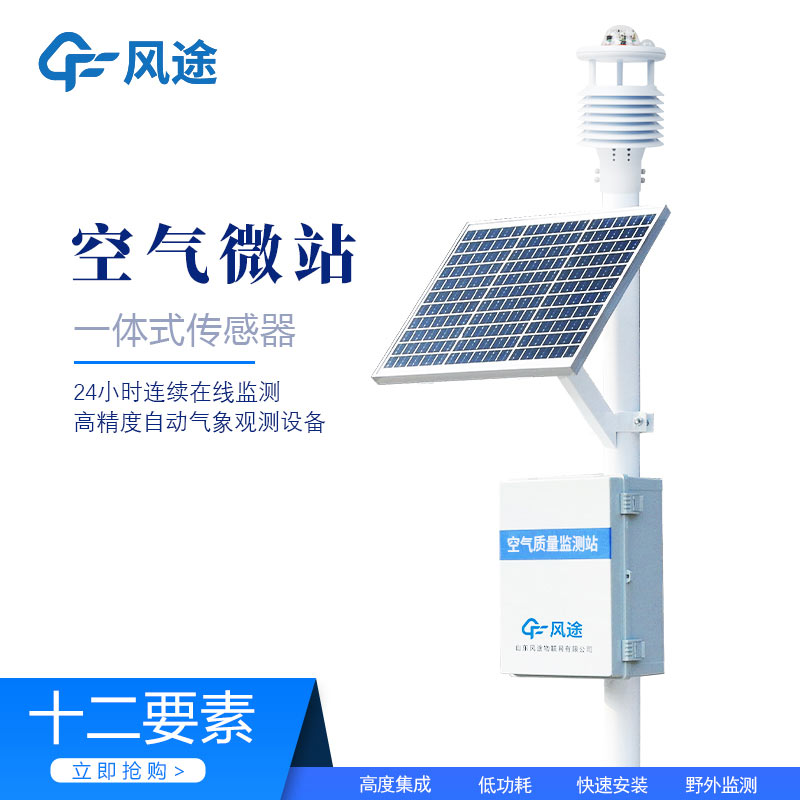Tianqiong Sensor IOT Technology Co., Ltd
Sales Manager:Ms. Emily Wang
Cel,Whatsapp,Wechat:+86 15898932201
Email:info@fengtutec.com
Add:No. 155 Optoelectronic Industry Accelerator, Gaoxin District, Weifang, Shandong, China

Sales Manager:Ms. Emily Wang
Cel,Whatsapp,Wechat:+86 15898932201
Email:info@fengtutec.com
Add:No. 155 Optoelectronic Industry Accelerator, Gaoxin District, Weifang, Shandong, China
time:2025-03-31 09:47:01 source:Weather Station viewed:177 time
In the context of the increasingly accelerating urbanization process today, air quality has become one of the key elements for measuring the quality of life. However, due to the high construction and operation costs and fixed layout, traditional large-scale environmental monitoring stations find it difficult to achieve refined and dynamic monitoring of urban air quality. Against this backdrop, the Air quality monitoring station has emerged, providing a new solution for urban air quality monitoring.
Although traditional air quality monitoring stations can cover a large area, they have many problems. Firstly, there are many monitoring blind spots, making it difficult to conduct comprehensive and accurate monitoring of areas such as urban streets, residential communities, and industrial parks. Secondly, the data update speed is slow, and it cannot reflect the real-time changes in air quality in a timely manner. Moreover, the high construction and maintenance costs limit the number and layout of monitoring stations, making it difficult to meet the refined requirements of urban air quality monitoring.
The emergence of the Air quality monitoring station effectively makes up for the deficiencies of traditional monitoring stations. It has a flexible deployment and can penetrate into small areas to achieve accurate monitoring, being able to capture the dynamic changes in air quality in a timely and accurate manner. At the same time, the relatively low cost makes large-scale deployment possible, and a dense air quality monitoring network can be constructed in every corner of the city, thus achieving comprehensive and real-time monitoring of urban air quality.
Although the Air quality monitoring station is small in size, it integrates high-precision sensors and intelligent Internet of Things technology. Its core working principles include the optical scattering method for detecting particulate matter (such as PM2.5 and PM10) and the electrochemical analysis method for monitoring harmful gases (such as SO₂, NO₂, O₃, CO, etc.). Combined with 4G/5G wireless transmission technology, this system can upload the monitoring data to the cloud platform in real time, enabling rapid data processing and sharing.
The advantages of the Air quality monitoring station are mainly reflected in the following aspects:
Flexible expansion: It supports the selection of monitoring parameters according to actual needs, such as noise, hydrogen sulfide, etc., and can meet the diversified monitoring needs of different scenarios such as industrial parks and transportation hubs.
Green power supply: It adopts a dual-mode power supply design of solar energy and utility power, reducing the limitations of wiring. It is especially suitable for deployment in remote areas, improving the adaptability and reliability of the system.
Intelligent early warning: When the monitoring data exceeds the standard, the system can automatically trigger an alarm and can be linked with cameras or spray dust suppression equipment to achieve rapid intervention at the pollution source, effectively improving the efficiency of air quality supervision.
In conclusion, as a new type of air quality monitoring technology, the Air quality monitoring station has the advantages of flexible deployment, low cost, accurate monitoring, and strong real-time performance. It can effectively make up for the deficiencies of traditional monitoring stations, providing more comprehensive, timely, and accurate data support for urban air quality monitoring. This is conducive to improving the level of urban environmental management and governance and enhancing the quality of life of urban residents.

The High-precision handheld three-element meteorological station is a portable meteorological observation instrument that measures key parameters such as wind speed, wind direction, and average wind speed. This device utilizes precision sensors and intelligent chips, making it easy to carry and operate. It is suitable for meteorological monitoring in outdoor environments such as remote mountainous areas, farmland, and grasslands....
In the context of the increasingly accelerating urbanization process today, air quality has become one of the key elements for measuring the quality of life. However, due to the high construction and operation costs and fixed layout, traditional large-scale environmental monitoring stations find it...
A School Weather Station is a comprehensive device established on campus that can automatically, continuously, and in real-time observe and record various meteorological elements. Composed of sensors, data loggers, power supply systems, communication modules, and data display platforms (such as camp...
Against the backdrop of accelerating informatization in water conservancy, the demand for monitoring in the field of water conservancy management is rising increasingly. To address issues such as frequent flood disasters and the need to improve the efficiency of water resource management, a Water Le...